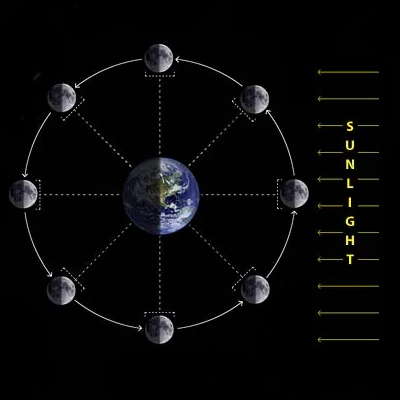
The Moon's Phases
- New Moon
- Occurs when the Sun's light is completely blocked from the Moon by the Earth
- Waxing Crescent
- Occurs when the Sun's light is beginning to reflect off of the Moon's surface and the Moon is less than half illuminated on the right
- First Quarter
- Occurs when the moon is perpendicular to the Earth and Sun causing it to appear exactly half illuminated on the right
- Waxing Gibbous
- Occurs when the Moon is more than half illuminated and is approaching Full Moon Status
- Full Moon
- Occurs when the Earth is Directly between the Sun and Moon but not blocking it. This allows the sun to fully illuminate the Moon's face
- Waning Gibbous
- Occurs when the Moon is more than half illuminated and is approaching half illuminated on the left
- Last Quarter
- Occurs when the Moon is perpendicular to the Earth and Sun causing it to appear exactly half illuminated on the left
- Waning Crescent
- Occurs when the Sun's light is ending it's reflection off of the Moon's surface and the Moon is less than half illuminated on the left
The Sun's Light

As you can see, the Moon's orbit and relation to the Sun is the cause of the different phases.
When the moon is directly between the Earth and Sun, it is still illuminated by the Sun, but the light is facing away from the Earth.
The same phenomenon works vice versa when the Earth is between the Moon and Sun, on Earth we see it fully illuminated because the
illuminated side is facing towards the Earth. These are our Full and New Moon Phases.
When the Moon is directly perpendicular to the Earth, you can see how the Sun's light causes it to appear half illuminated.
These are our First and Last Quarter Moon Phases.
When the Moon is in between Full and Quarter Phases, we get our Crescents and Gibbous Phases.
The phases closest to the sun are Crescents as they are approaching or have just been New Moons.
And the phases furthest from the Sun are Gibbouses as they are approaching or have just been Full Moons.
Apollo Missions
| Mission Name | Launch Date | Launch Vehicle | Mission Type | Mission Success |
|---|---|---|---|---|
| Apollo 1 | Jan. 27, 1967 | AS-204 | Earth Orbit | Failure |
| Apollo 7 | Oct. 11, 1968 | Apollo CSM-101 | Earth Orbit | Success |
| Apollo 8 | Dec. 21, 1968 | Apollo CSM-103 | Lunar Orbit | Success |
| Apollo 9 | Mar. 3, 1969 | Apollo CSM-104 | Earth Orbit | Success |
| Apollo 10 | May 18, 1969 | Apollo CSM-106 | Lunar Orbit | Success |
| Apollo 11 | July 16, 1969 | Apollo CSM-107 | Lunar Landing | Success |
| Apollo 12 | Nov. 14, 1969 | Apollo CSM-108 | Lunar Landing | Success |
| Apollo 13 | Apr. 11, 1970 | Apollo CSM-109 | Lunar Landing | Failure |
| Apollo 14 | Jan. 31, 1971 | Apollo CSM-110 | Lunar Landing | Success |
| Apollo 15 | July 26, 1971 | Apollo CSM-112 | Lunar Landing | Success |
| Apollo 16 | Apr. 16, 1972 | Apollo CSM-113 | Lunar Landing | Success |
| Apollo 17 | Dec. 7, 1972 | Apollo CSM-114 | Lunar Landing | Success |
Moon Facts
- Moon's Orbit
- Our Moon takes 27.3 days to orbit the Earth and 29.5 days to complete a full moon cycle. The moon cycles through 8 main phases as pictured above.
- Moon's Size
- The Moon is 1/4 the size of the Earth and is the 5th largest moon in our solar system.
- Moonquakes
- The Moon experiences moonquakes, which are similar to earthquakes but are generally less intense. They are believed to be caused by the gravitational interactions with Earth.
- Earthshine
- You can sometimes see a faint glow on the dark part of the Moon during a crescent phase. This is called "Earthshine" and is caused by sunlight reflecting off Earth and illuminating the Moon.
- Moon's Dust Storms
- The Moon experiences periodic "dust storms" caused by micrometeoroid impacts, which can create a thin, temporary atmosphere of lunar dust.
- Moon's Ice Water
- Recent missions have discovered water ice on the Moon's surface, primarily in permanently shadowed craters near the lunar poles.